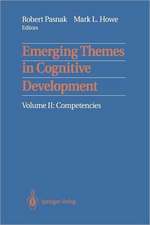Elements of Robotics
Autor Mordechai Ben-Ari, Francesco Mondadaen Limba Engleză Paperback – 9 noi 2017
Elements of Robotics presents an overview of different types of robots and the components used to build robots, but focuses on robotic algorithms: simple algorithms like odometry and feedback control, as well as algorithms for advanced topics like localization, mapping, image processing, machine learning and swarm robotics. These algorithms are demonstrated in simplified contexts that enable detailed computations to be performed and feasible activities to be posed. Students who study these simplified demonstrations will be well prepared for advanced study of robotics.
The algorithms are presented at a relatively abstract level, not tied to any specific robot. Instead a generic robot is defined that uses elements common to most educational robots: differential drive with two motors, proximity sensors and some method of displaying output to the user.
The theory is supplemented with over 100 activities, most of which can be successfully implemented using inexpensive educational robots. Activities that require more computation can be programmed on a computer. Archives are available with suggested implementations for the Thymio robot and standalone programs in Python.
Preț: 333.95 lei
Preț vechi: 417.44 lei
-20% Nou
Puncte Express: 501
Preț estimativ în valută:
63.92€ • 66.44$ • 52.95£
63.92€ • 66.44$ • 52.95£
Carte tipărită la comandă
Livrare economică 31 ianuarie-06 februarie 25
Preluare comenzi: 021 569.72.76
Specificații
ISBN-13: 9783319625324
ISBN-10: 3319625322
Pagini: 308
Ilustrații: XVI, 308 p. 198 illus., 76 illus. in color.
Dimensiuni: 155 x 235 x 20 mm
Greutate: 0.84 kg
Ediția:1st ed. 2018
Editura: Springer
Colecția Springer
Locul publicării:Cham, Switzerland
ISBN-10: 3319625322
Pagini: 308
Ilustrații: XVI, 308 p. 198 illus., 76 illus. in color.
Dimensiuni: 155 x 235 x 20 mm
Greutate: 0.84 kg
Ediția:1st ed. 2018
Editura: Springer
Colecția Springer
Locul publicării:Cham, Switzerland
Cuprins
Robots and their Applications.- Sensors.- Reactive Behavior.- Finite State Machines.- Robotic Motion and Odometry.- Control.- Local Navigation: Obstacle Avoidance.- Localization.- Mapping.- Mapping-based Navigation.- Fuzzy Logic Control.- Image Processing.- Neural Networks.- Machine Learning.- Swarm Robotics.- Kinematics of a Robotic Manipulator.- Appenix A:Units of Measurement.- Appendix B:Mathematical Derivations and Tutorials.- Index.
Recenzii
“The book is a valuable and lucidly written introduction to the area of robotics. It does a very good job by delivering a sound and coherently structured topics central to the robotics area. … The book would appeal to a broad audiences of high school students, undergraduate students and all of those who have interest in the basics. Overall, this is a well-thought out indispensable material of a solid educational value.” (Witold Pedrycz, zbMATH 1407.93001, 2019)
Notă biografică
Mordechai (Moti) Ben-Ari is with the Department of Science Teaching at the Weizmann Institute of Science. He has written many textbooks including Mathematical Logic for Computer Science (Springer, 2012). Ben-Ari is a Distinguished Educator of the ACM and has received the ACM/SIGCSE Award for Outstanding Contributions to Computer Science Education.
Francesco Mondada is with the Laboratory of Robotics Systems at the Ecole Polytechnique Fédérale de Lausanne (EPFL). He has co-designed several mobile robots for research and education that are used in thousands of schools. Mondada has received several awards, including the Latsis Prize and the Credit Suisse Best Teaching Award.
Francesco Mondada is with the Laboratory of Robotics Systems at the Ecole Polytechnique Fédérale de Lausanne (EPFL). He has co-designed several mobile robots for research and education that are used in thousands of schools. Mondada has received several awards, including the Latsis Prize and the Credit Suisse Best Teaching Award.
Textul de pe ultima copertă
This book is open access under a CC BY 4.0 license.
This book bridges the gap between playing with robots in school and studying robotics at the upper undergraduate and graduate levels to prepare for careers in industry and research. Robotic algorithms are presented formally, but using only mathematics known by high-school and first-year college students, such as calculus, matrices and probability. Concepts and algorithms are explained through detailed diagrams and calculations.
Elements of Robotics presents an overview of different types of robots and the components used to build robots, but focuses on robotic algorithms: simple algorithms like odometry and feedback control, as well as algorithms for advanced topics like localization, mapping, image processing, machine learning and swarm robotics. These algorithms are demonstrated in simplified contexts that enable detailed computations to be performed and feasible activities to be posed. Students who study these simplified demonstrations will be well prepared for advanced study of robotics.
The algorithms are presented at a relatively abstract level, not tied to any specific robot. Instead a generic robot is defined that uses elements common to most educational robots: differential drive with two motors, proximity sensors and some method of displaying output to the use.
The theory is supplemented with over 100 activities, most of which can be successfully implemented using inexpensive educational robots. Activities that require more computation can be programmed on a computer. Archives are available with suggested implementations for the Thymio robot and standalone programs in Python.
This book bridges the gap between playing with robots in school and studying robotics at the upper undergraduate and graduate levels to prepare for careers in industry and research. Robotic algorithms are presented formally, but using only mathematics known by high-school and first-year college students, such as calculus, matrices and probability. Concepts and algorithms are explained through detailed diagrams and calculations.
Elements of Robotics presents an overview of different types of robots and the components used to build robots, but focuses on robotic algorithms: simple algorithms like odometry and feedback control, as well as algorithms for advanced topics like localization, mapping, image processing, machine learning and swarm robotics. These algorithms are demonstrated in simplified contexts that enable detailed computations to be performed and feasible activities to be posed. Students who study these simplified demonstrations will be well prepared for advanced study of robotics.
The algorithms are presented at a relatively abstract level, not tied to any specific robot. Instead a generic robot is defined that uses elements common to most educational robots: differential drive with two motors, proximity sensors and some method of displaying output to the use.
The theory is supplemented with over 100 activities, most of which can be successfully implemented using inexpensive educational robots. Activities that require more computation can be programmed on a computer. Archives are available with suggested implementations for the Thymio robot and standalone programs in Python.
Caracteristici
Presents algorithms at a high-level that can be adapted for use with any educational robot
Demonstrates advanced topics (localization, mapping, machine learning, swarm robotics) in simplified contexts
Facilitates the transition from playing with robots to studying robotics for industrial and research applications
Includes supplementary material: sn.pub/extras
Demonstrates advanced topics (localization, mapping, machine learning, swarm robotics) in simplified contexts
Facilitates the transition from playing with robots to studying robotics for industrial and research applications
Includes supplementary material: sn.pub/extras





























